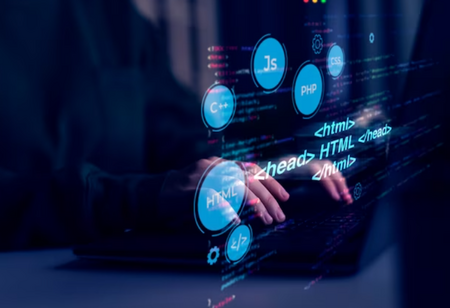Web 5.0: Making the Transition from Connectivity to Intelligence
By Shiwani Pradhan, Correspondent, Consultants Review
 The next version of the Internet, known as Web 5.0, has specialists from all over the world interested because it promises dramatic change. Building on the groundwork established by earlier incarnations of the internet, this latest development integrates cutting-edge technology like blockchain, artificial intelligence, and enhanced connection. Web 5.0's intelligent, decentralized, and immersive experience is the result of the Internet's dynamic journey, which changed Web 1.0's static material. As we reach this next frontier, a paradigm shift may dramatically alter how we interact with the digital world.
The next version of the Internet, known as Web 5.0, has specialists from all over the world interested because it promises dramatic change. Building on the groundwork established by earlier incarnations of the internet, this latest development integrates cutting-edge technology like blockchain, artificial intelligence, and enhanced connection. Web 5.0's intelligent, decentralized, and immersive experience is the result of the Internet's dynamic journey, which changed Web 1.0's static material. As we reach this next frontier, a paradigm shift may dramatically alter how we interact with the digital world.
The Stages of Web 1.0 to Web 5.0
The World Wide Web has evolved, being managed to be able to rise to the occasion and persevere with the tenacity to keep up and regenerate for the next stage of existence. Web 5.0 assures that the best drivers from Web 4.0 are enhanced and augmented with the element of control, reconfiguration, and realignment, in the bigger picture of stakeholders in the company, society, and human existence in general. The early stages of Web 1.0 emerged during the era of dial-up communications, where users were presented with a static online directory with text-based primary functions. That early version lacked interactivity and limited users to passive participation.
The 1999 release of Web 2.0 signaled a dramatic change. In this stage, users could actively participate by creating content, posting, and participating in online discussion boards. Pioneering companies like Amazon, Google, and Microsoft dominated this era and promoted a collaborative and participatory online environment.
The next development Web 3.0 ushered in a highly decentralized landscape, particularly influenced by the cryptocurrency, Metaverse. This phase focused on improving the user experience by applying emerging technologies and principles to circuits. With these developments, Web 4.0 further enhanced user experience by incorporating intelligent systems and sophisticated technologies. Automation has been key, streamlining processes and transactions, and paving the way for a seamless and efficient digital experience.
Now looming is the anticipated Web 5.0. Now, this next step in development aims to push the boundaries of decentralization, connectivity, automation, and intelligence. Increased connectivity on more decentralization emphasizes the elimination of centralized control structures, which can foster a more democratic and distributed online ecosystem Increased connectivity promises an interconnected network in the form of it is robust, resulting in a network that is not only large but also strongly connected There is a flexible and efficient digital environment. The digital environment is anticipated to change with the introduction of Web 5.0. The upcoming version of the Internet has the capacity to fundamentally transform how people use it with its unique blend of decentralization, connectedness, automation, and intelligence.
Harmony of Web 5.0 and Industry 5.0 for Transformational Changes
The latest development currently underway, Web 5.0, is the next step in this evolutionary process. Its goals include greater decentralization, connectivity, automation, and intelligence, which promises to bring transformational change in how we see and use the internet It has been suggested that Web 5.0 is a major enabler of Industry 5.0, or the "fifth technological revolution." These technological advances, which strategically integrate automation and artificial intelligence, have the potential to completely change traditional manufacturing. Efficiency and profitability gains become more apparent for organizations that can take advantage of this shift.
The deployment of 5G networks is a key driver of Industry 5.0. Drones and self-driving cars are examples of Industry 5.0 technology that depend on 5G's fast data transfer capabilities. These interconnected technologies not only ensure safe but efficient industrial design, as real-time data transfer becomes the cornerstone of modern industrial practice.
Web 5.0 isn’t just an advancement in technology; it is about user experiences, providing dynamic and personalized interaction. One notable feature of Web 5.0 is the ability to use facial recognition to map the emotions of consenting users. This feature enables websites to dynamically adapt to their users' preferences, resulting in an immersive and responsive online experience.
However, Web 5.0 is more than just technological advancements. It returns power to users, giving them greater control over their identities and data. This shift towards the user represents a departure from traditional interaction and emphasizes the importance of privacy and freedom in the digital age.
The promise of Web 5.0 has given rise to optimistic visions of the harmonization of people and machines. In this envisioned future, companies, employees, customers, and the public all stand to benefit from a seamless integrated technology system. The expectation is a digital environment that is user-friendly, functional, and efficient. Despite these optimistic visions, the impact of Web 5.0 extends beyond statistics. It might significantly affect how people conduct themselves, perform their jobs, and correspond on a global scale. Web 5.0 has the same potential to drastically alter established businesses as Industry 5.0.
All things considered, Web 5.0 is a huge advancement in the development of the Internet and can completely change user experiences as well as services. Because of its synergies with Industry 5.0, there are previously unheard-of chances for greater creativity and productivity. Its synergies with Industry 5.0 present unprecedented opportunities for increased productivity and innovation. Whether fulfilling utopian visions or posing unforeseen challenges, the reality of Web 5.0 will surely extend beyond mere fantasy. As we stand at this digital frontier, the combination of artificial intelligence automation and user empowerment creates an era of unprecedented possibilities and opportunities to announce and set the course for a fifth industrial revolution.







